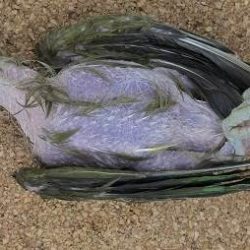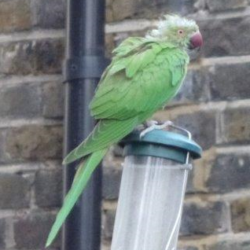Agent
Psittacine Beak and Feather Disease (PBFD) has been detected in captive and free-living parrots since the 1970s. Its causative agent is the Beak and Feather Disease virus (BFDV), which belongs to the Circoviridae family of viruses.
Species affected
All psittacines (parrot species) are thought to be susceptible to PBFD, with cases documented in 78 species of parrot to date worldwide.
As Great Britain (GB) is home to no native psittacines, the only free-living species affected by PBFD thus far is the invasive ring-necked (or rose-ringed) parakeet (Psittacula krameri) (RNP). Although in general other native bird families are not known to be at risk from PBFD, in 2015 infection was confirmed in one species of Coraciiforme (kingfishers, bee-eaters) and Strigiforme (owls), the rainbow bee-eater (Merops ornatus) and powerful owl (Ninox strenua) respectively, in Australia. While the significance of these findings is not yet known, they provide evidence of the potential for BFDV to affect non-psittacine species.
Signs of disease
PBFD is known to cause severe disease and mortality in captive and wild psittacines. The signs of disease can vary however, often depending on the age at which infection occurs and how rapidly the condition progresses. The signs most frequently associated with PBFD include symmetrical loss and clumping of feathers, and abnormal plumage colouration. Over time, affected birds may become completely bald. Also, as the name implies, beak abnormalities, for example cracks and overgrowth can occur. It is important to note that these signs can take some time to develop, so it is possible for a bird to be infected, yet show no symptoms.
In addition to this classical presentation of disease, birds infected when between 6-24 months old have been documented with signs of depression, diarrhoea, lethargy and immunosuppression (a weakened immune system), in the absence of beak or feather abnormalities. Affected birds often go on to develop secondary infections with other viruses or bacterial agents. Moreover, in some cases, particularly in birds less than 6 months old, sudden death can occur where no signs of ill-health were previously noted.
(Left) Figure 1. Ring-necked parakeet (Psittacula krameri) with showing feather loss associated with PBFD. Photo credit: Sa et al (2014)
(Right) Figure 2. Suspected PBFD in a ring-necked parakeet (Psittacula krameri) in Greater London. Photo credit: P. Price-Tomes
Disease transmission
BFDV is excreted (shed) in faeces, oral secretions and feather dander, enabling transmission through direct and indirect contact of infected and susceptible individuals. It is also possible for birds that carry the virus to transmit the disease to their eggs, and young birds may be infected via regurgitated food from infected parents.
The virus can survive in the environment for several months, meaning that contaminated materials can remain a source of infection for prolonged periods of time.
Distribution and origin
On a global scale, PBFD is considered to be one of the most important infectious diseases of both wild and captive psittacines. Thought to have originated in Australia, it has now been identified in Europe, North America, Asia and Africa, with the spread of disease largely attributed to the global movement of captive parrot species for the pet trade.
In Great Britain, free-living RNPs are predominantly found in the South East of England, including a population of an estimated 30,000 residing in the Greater London area. The first report of PBFD in a free-living RNP in GB was confirmed in 2012 in London: the affected bird showed typical signs of plumage abnormality with feather loss affecting the head and body.
Two additional free-living RNPs with confirmed BFDV infection yet no plumage abnormalities have been confirmed in the Greater London area. A small number of RNPs with plumage abnormalities in Greater London have been reported to the GWH project where PBFD is suspected to be the cause.
Further research is required into the distribution of BFDV in RNPs in GB, and how frequently PBFD occurs. Whether BFDV is well established in the wild population of RNPs in GB, but infrequently causes disease, or whether this viral infection is emerging remains unknown.
Risk to human health
No known risk to human health.
Risk to domestic animal health
PBFD poses no known risk to domestic mammal health. However, a health threat exists to captive psittacines. Routine biosecurity measures are therefore recommended for aviaries to prevent transmission of disease from wild to captive psittacines. This should involve eliminating the risk of direct contact with infected birds and any potentially infectious material such as faeces and feather dander, for example by covering aviaries and ensuring no shared feeding/bathing areas between wild and captive birds.
Diagnosis
Due to the variation in clinical signs, and the numerous other potential causes of similar symptoms, PBFD cannot be diagnosed based on the presence of feather abnormalities alone. To definitively diagnose the disease, further investigation and specialist laboratory testing is required.
If you wish to report finding a dead bird, or signs of disease in birds, please visit www.gardenwildlifehealth.org. Alternatively, if you have further queries or have no internet access, please call the Garden Wildlife Health vets on 0207 449 6685.
Prevention and control
Whilst supportive treatment can be attempted in captive birds with PBFD, effective treatment of free-living birds under field conditions is not possible.
In areas where free-living RNPs are found, strict hygiene and biosecurity measures are recommended to protect captive psittacines from contact with potentially infectious material (see ‘Transmission’ above).
Scientific publications
Fogell DJ, Martin RO, Bunbury N, Lawson B, Sells J, McKeand AM, Tatayah V, Trung CT, Groombridge JJ (2018) Trade and conservation implications of new beak and feather disease virus detection in native and introduced parrots. Conservation Biology 32(6) p.1325-1335 doi.org/10.1111/cobi.13214
Sarker S, Lloyd C, Forwood J, Raidal SR, (2016) Forensic genetic evidence of beak and feather disease virus infection in a Powerful Owl, Ninox strenua. Emu 116(1), pp.71-74 doi.org/10.1071/MU15063
Fogell DJ, Martin RO Groombridge JJ, (2016) Beak and feather disease virus in wild and captive parrots: an analysis of geographic and taxonomic distribution and methodological trends. Archives of virology 161(8), p.2059-2074 doi.org/10.1007/s00705-016-2871-2
Sarker S, Moylan KG, Ghorashi SA, Forwood JK, Peters A, Raidal SR (2015) Evidence of a deep viral host switch event with beak and feather disease virus infection in rainbow bee-eaters (Merops ornatus). Scientific reports, 5 doi.org/10.1038/srep14511
Sa RCC, Cunningham AA, Dagliesh MP, Wheelhouse N, Pocknell A, Borel N, Peck HL, Lawson B (2014) Psittacine beak and feather disease in a free-living ring-necked parakeet (Psittacula krameri) in Great Britain. Eur J Wildl Res 60: 395 doi.org/10.1007/s10344-013-0792-x
Acknowledgements
Current funding for the GWH comes in part from Defra, the Welsh Government and the Animal and Plant Agency (APHA) Diseases of Wildlife Scheme (DoWS) http://apha.defra.gov.uk/vet-gateway/surveillance/seg/wildlife.htm; and from the Esmée Fairbairn Foundation, the Universities Federation for Animal Welfare and the Garfield Weston Foundation.
Disclaimer
This fact sheet was produced by Garden Wildlife Health (GWH) for information purposes only. The GWH will not be liable for any loss, damage, cost or expense incurred in or arising by reason of any person relying on information in this fact sheet.
Date of last update


